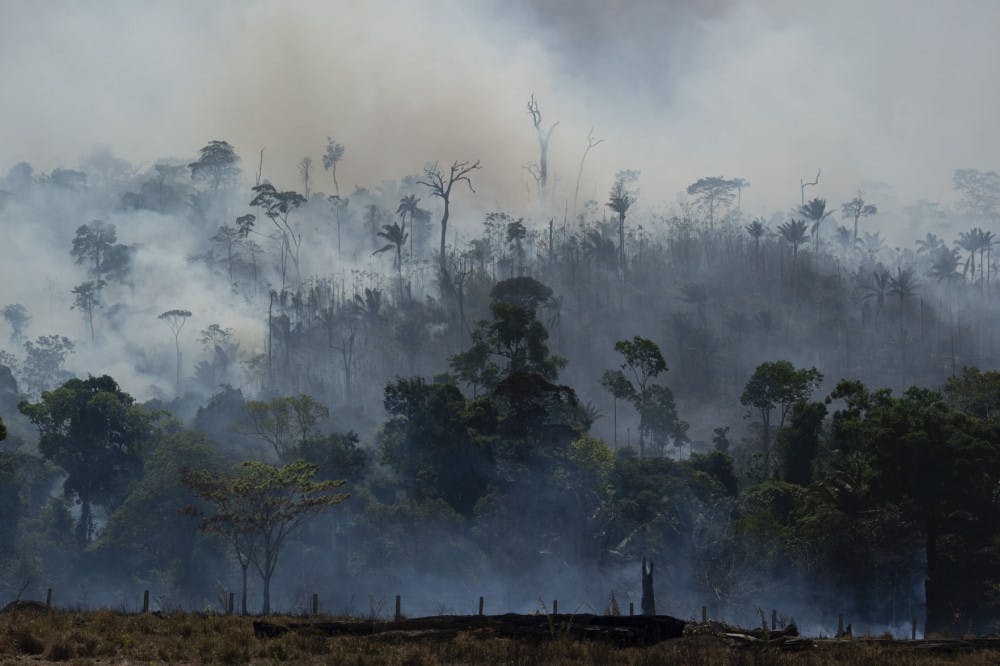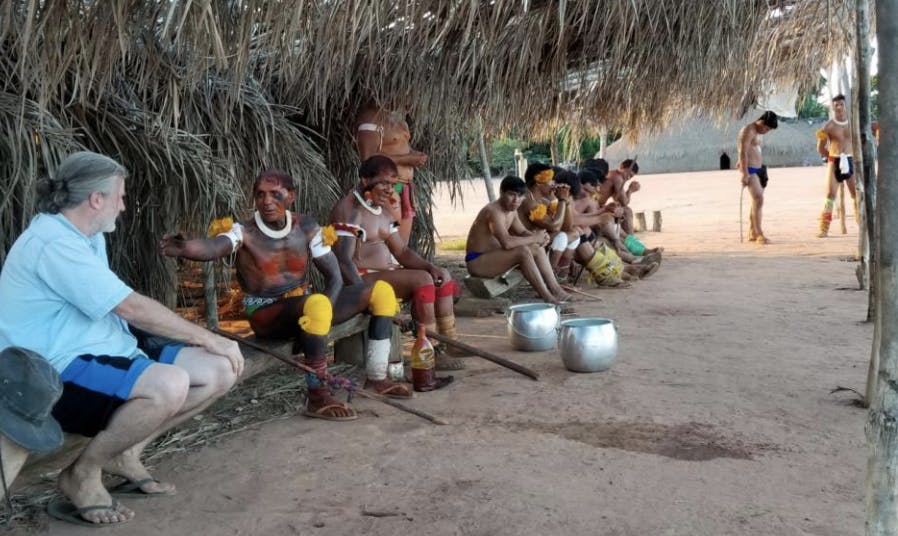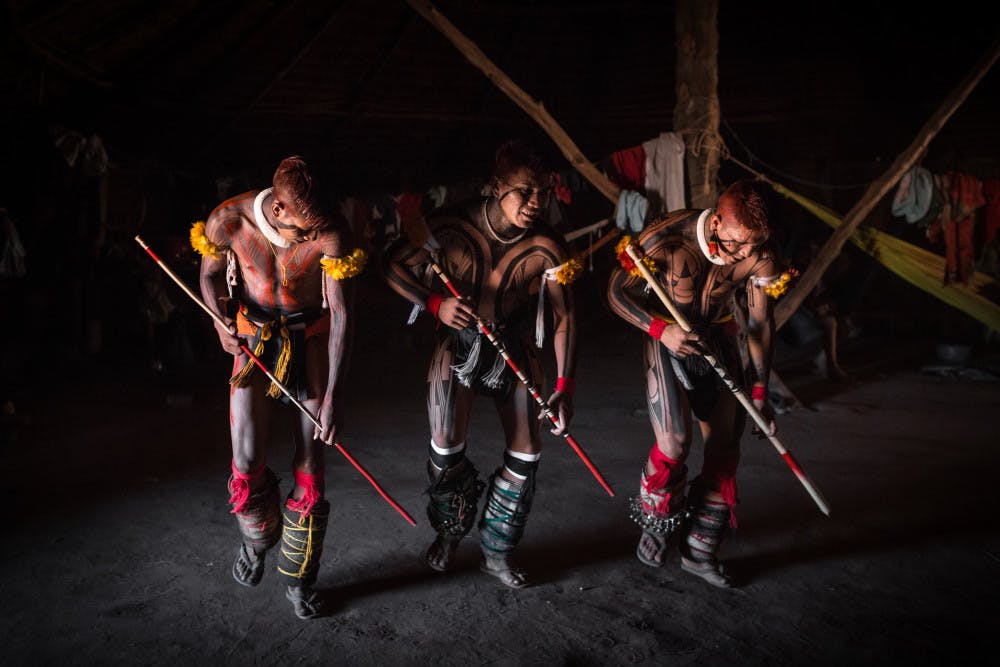When UF anthropology professor Michael Heckenberger worked in the Brazilian Amazonrainforest, the sky wasn’t always blue.
During his stay in the early 2000s, Heckenberger woke up in an indigenous chief’s wooden house, slid out of his hammock and stepped across the dirt floor into the village. It was set in a circular clearing dotted with other houses and surrounded by thick green trees.
But the air choked with gray smoke, scratched at his throat, and the sky was red from the fires raging in the forest next door.
In 2019, fires are still burning — and it’s only getting worse.
Brazil’s National Institute for Space Research reported that satellites spotted almost 40,000 fires in the Amazon this year, which is 77 percent more than in 2018.
Heckenberger spent 27 years documenting the indigenous Kuikuropeople, a group of about 500 people living near the Amazon’s Xingu River. He said the tribe and the rainforest it calls home are under attack from the recent increase in fires.
“Ground Zero are the indigenous people that I work with,” Heckenberger said. “Their livelihoods will be destroyed.”
This is why Heckenberger had the idea to create Amazon Hope, an event scheduled for Oct. 9 to Oct. 11 in New York City where indigenous tribe leaders, university scholars and scientists will meet to brainstorm solutions and spread awareness about the Amazon fires. And it’s not just about Brazil — if the Amazon continues to burn, the global climate will suffer.

A fire burns in highway margins in the city of Porto Velho, Rondonia state, part of Brazil's Amazon, Sunday, Aug. 25, 2019. (AP Photo/Eraldo Peres)
Hack, slash and burn: the Amazon’s history of deforestation and fires
Fires aren’t new to the Amazon. What’s new is the skyrocketing number of them, said Maíra Irigaray, a UF geography doctoral student who’s worked for activist groups in Brazil since she was 13.
“I see a lot of people that have been very outraged with the news,” Irigaray said. “But it’s not news for us. Those fires have always happened in the Amazon every year.”
Irigaray was the Brazil Program Coordinator for Amazon Watch, a nonprofit that protects the Amazon and its people. It wasn’t an easy job — for months, she received death threats and only slept for three hours a night. She watched villagers fall into depression after they lost their homes to fire.
The burns are man-made because fire is an agricultural tool in Brazil, said UF professor for the Center for Latin American Studies Robert Walker, who studied Amazon deforestation for 25 years.
Walker said after deforesters cut down trees, they burn the land to choke out invasive plant species, use the ashes as fertilizer and utilize cleared land for farming and building.
However, when the forest burns repeatedly, seeds die and plants can no longer grow. With the trees gone, the land loses protection from evaporation, leaving the forest even drier than before.
If the Amazon collapses and can no longer recycle water, it will affect the entire world, Walker said. Droughts could settle into the Mississippi Valley, and change rainfall patterns in Israel, Argentina and drier parts of Brazil.
Brazil’s government, knowing the environmental detriments, implemented a series of restrictions on deforestation in the early 2000s. But Brazilian President Jair Bolsonaro came into office this January with a pro-deforestation agenda, and the fires have been increasing ever since, Walker said.
About 20 percent of the Amazon has already been burned down. The entire Amazon is about half as big as the continental U.S., with the burned portion the size of Texas, Walker said.
“If nothing is done, there’s no doubt in my mind that within the next decade, the forest will be pushed to one of these precipitate points,” Walker said. “It’s in a critical state, and it’s just going to get more critical. There’s a good chance that in [our] lifetime the forest will be gone.”

Fire consumes the Amazon rainforest in Altamira, Brazil, on Tuesday, Aug. 27, 2019. Fires across the Brazilian Amazon have sparked an international outcry for preservation of the world's largest rainforest. (AP Photo/Leo Correa)
Planning for the future: Amazon Hope
Ana Cavalcante, a 19-year-old UF political science sophomore and Brazilian Student Organization member, said the Amazon is burning in all directions — including her mother’s hometown of Porto Velho, Rondônia.
Cavalcante lived in Brazil until she was 7 years old, and spent two of those years in Porto Velho with her grandparents. They still live there, and recently haven’t brought good news during phone calls.
“They say that you wake up in the morning, and there’s this thick thing in the air. And you think it might be sleet or fog, but once you see it, it’s actually smoke,” Cavalcante said. “It’s everywhere.”
She said that Rondônia has some of the most concentrated fires in Brazil, but nobody is dedicating enough resources to stop it despite the preservation of other global treasures.
“We have the instance of Notre Dame. That burned, and that got international attention, and people were sending millions of dollars to reconstruct it,” Cavalcante said. “But the Amazon, you can’t really reconstruct it — at least in our lifetime.”
Cavalcante isn’t the only person holding onto hope for the forest, which is why Heckenberger decided to host the pro-environment summit ‘Amazon Hope’ later this fall in New York.
More than 50 people were hand-picked to attend the summit, including indigenous tribe leaders and pro-environment organizations from around the world such as Instituto Socioambiental, the Environmental Defense Fund, People’s Palace Projects and the University of São Paulo, said Elizabeth Subin, the director of Vermont’s Pennywise Foundation, one of the event sponsors.
Participants will gather at Affirmation Arts in New York City to brainstorm ideas to reduce fires. The goal is to leave the event with a tangible to-do list, but they also want to raise awareness for the situation.
Pennywise foundation, a humanitarian organization, has been working with Heckenberger for two years on a project called ‘Ipatse Futures’ to sustain Ipatse, a Kuikuro village, through environmental protection and economic opportunity, Subin said.
Affirmation Arts, the other event sponsor, will host an exhibit focused entirely on the Amazon that will include indigenous artwork, photographs of Kuikuro villages and people, a film made by Kuikuro people about climate change and more, Subin said.
Heckenberger ultimately wants Amazon Hope to be focused on the Kuikuro. The non-Kuikuro people attending the summit are “backup singers,” while the indigenous people are “headliners” and the summit a stage for them to tell their story.

Heckenberger watches Kuikuro performers prepare for a Hagaka ritual, in which they honor the dead, in 2018.
He recalled his early days with Kuikuro people, when the skies were red and he dug through the land to help preserve their history. Now, in his UF office between packed bookshelves and photos of him with Kuikuro people, he’s hoping his plans will help save them and the environment.
“It’s an area that some people have almost given up on,” Heckenberger said. “But again, that’s my family. I’ve lived [with Kuikuro people] for so long, and we’re so close, I consider them family, not research objects. And I’m not willing to give up the ship. There is still hope.”
A traditional dance performed by the indigenous Kuikuro people in the Brazilian Amazon, which Michael Heckenberger has worked with for the past 27 years. He designed Amazon Hope to help save these people and the rainforest they live in.





